Top 6 Benefits of BIM for Small Construction Firms
Building information modeling (BIM) software has something to offer everyone involved in a building project. It is a valuable tool at every stage of a building’s life cycle, from the initial design and construction phase to ongoing maintenance services, repairs, and upgrades—even demolitions.
BIM is gaining popularity among construction companies, but our findings suggest there might be barriers holding some firms back from implementing BIM software. Although more than one-third (36%) of construction firms use BIM, more than half (55%) do not*.
If you own a small construction company and are thinking about investing in BIM to scale your business, we’re here to help. In this article, we will explore what BIM is, its benefits and challenges, and what you should know before investing in a BIM platform for your construction company.
What is building information modeling (BIM)?
Building information modeling is a process supported by software that captures, organizes, and manages data used to design, engineer, construct, and operate built projects. BIM software is dynamic and serves different purposes in various stages of the building process.
For those in the construction industry, such as construction management, contractors, and suppliers, BIM can be especially useful in managing different stages of the project from start to finish, keeping track of operational and capital expenditures, reducing errors, and coordinating across teams.
Top benefits of BIM for construction companies
According to our recent survey*, 36% of small construction companies use BIM software. These small construction firms recognize the value BIM software adds to their business, reporting benefits such as enhanced project visualization, streamlined processes, improved collaboration, and error reduction.
Here are the top six benefits most frequently reported by small construction firms using BIM.
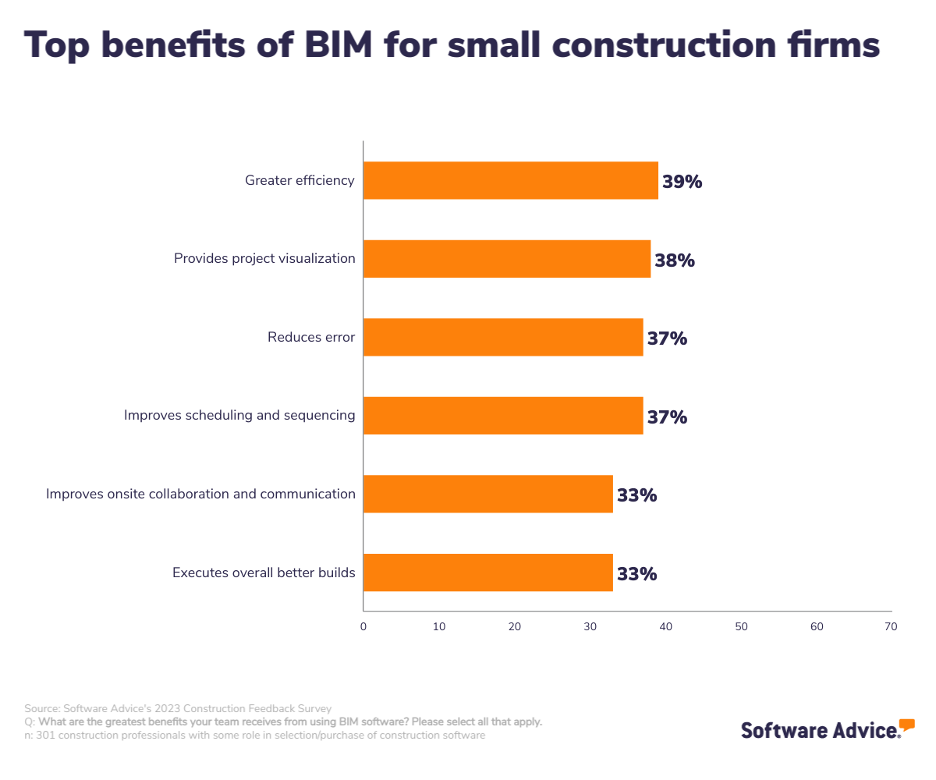
Benefit 1: Greater efficiency
Strong planning, organization, and communication are key ingredients to efficiency for any project, especially a construction project with so many hands on deck. You also have to coordinate many moving, interdependent parts, many of which need to be inspected before other stages of the project can begin.
When plans are clearly communicated ahead of time, your team won’t be left in the dark wondering what they need to be doing and when. But you can’t communicate plans if you, the manager, foreman, or team leader, don’t know them.
BIM software can help with this. Construction companies, such as yours, value efficiency, and 39% of companies say greater efficiency is a top benefit of using BIM software.
One way BIM platforms, such as BIM Track, can help is by allowing users to keep track of issues that need to be resolved.
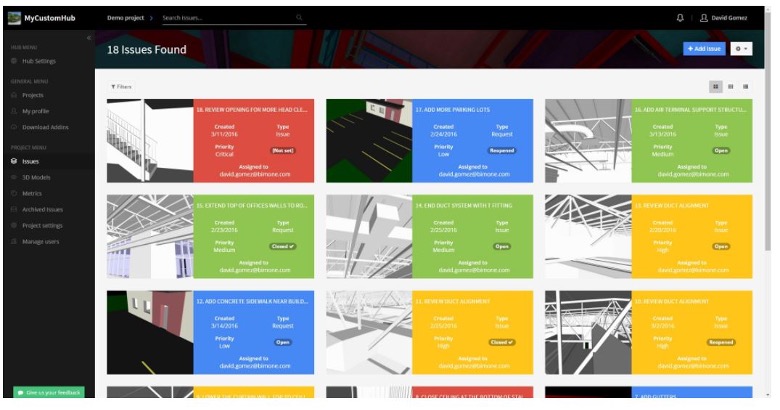
Issue management portal in BIM Track (Source)
This allows project managers to ensure issues are resolved on time, and the project sticks to its original timeline, avoiding delays and ultimately maximizing efficiency.
Benefit 2: Enhanced project visualization
To visualize a construction project from start to finish is not easy. To make sure the hundreds of people working on the project have the same vision is even more difficult. This is where BIM comes in.
BIM platforms provide construction teams with digital 3D visualizations of the building project, and 38% of BIM users report this as a top benefit.
For example, ARCHICAD, allows users to create and share 3D models of both the interior and exterior of the built project.

3D modeling in ARCHICAD (Source)
Users can also access CAD drawings, floor plans, and building models to gain a more thorough understanding of project design.
Benefit 3: Error reduction
Your employees cannot be productive if they have to constantly go back and redo work they’ve already completed. Having to constantly rework projects leads to wasted materials, time, and money, as well as a frustrated workforce.
Construction firms that use BIM software report error reduction (37%) as a top benefit. These platforms make it easy to keep track of projects that have been completed and ones that are still open.
For example, Autodesk Construction Cloud offers a submittal portal that makes it easy to keep track of all the moving pieces of a building project.
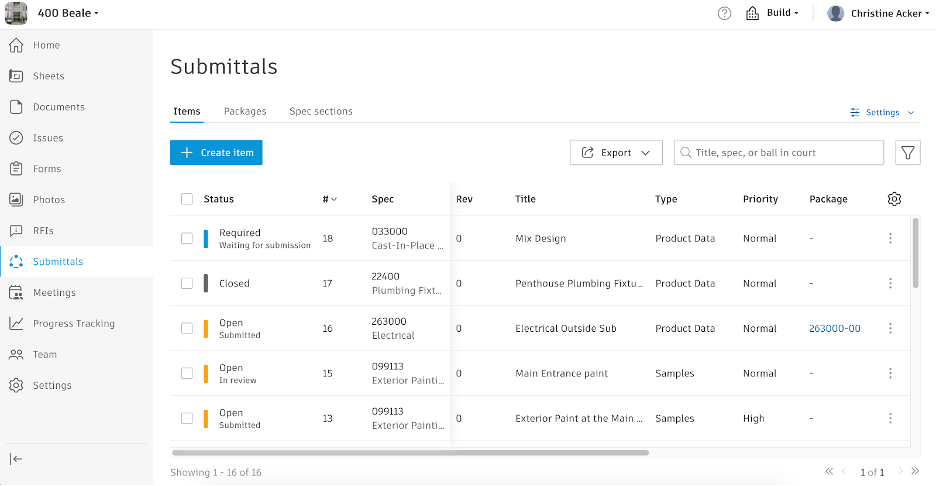
Submittal portal in Autodesk Construction Cloud (Source)
Users can easily see the status of each submittal, as well as the spec, title, type, and priority level. This will make it easier to make sure certain jobs are done on time and on spec to avoid rework and injury.
Benefit 4: Streamlined scheduling and sequencing
It can be difficult to manage all of the moving pieces of a construction project. Different teams should complete certain tasks at certain times, and if a task goes overlooked, it could mean time and resources wasted.
BIM software can improve scheduling and sequencing, and 37% of users say this is a top benefit. By using scheduling functionality on construction platforms such as Buildertrend, you can schedule the start date for tasks and specify how many days the task will take to complete.
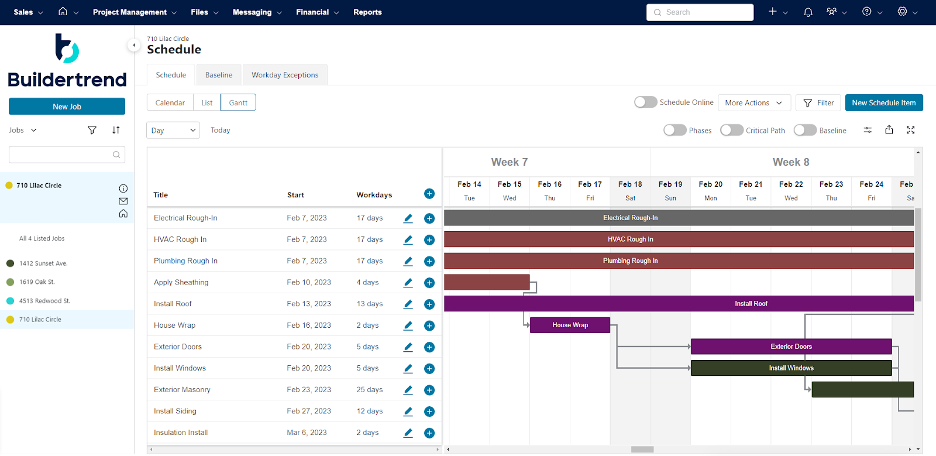
Scheduling tool in Buildertrend (Source)
This type of tool also allows you to see ongoing tasks as a calendar, list, and Gantt chart, depending on your view preference.
Benefit 5: Improved onsite collaboration and communication
While scheduling tools help you plan for collaboration, you also want to make sure the collaborative spirit transfers to the job site. This means you want to make sure everyone knows where they’ll be and what they’ll be working on on any given day.
One-third (33%) of BIM software users report improved onsite collaboration and communication. BIM platforms make it easier for collaborators to share data and information, making it easier for contractors, architects, and engineers to be on the same page.
Revit, for example, is a construction management software that allows users to coordinate using 3D modeling and color coding so that everyone is aware of any changes in real time.
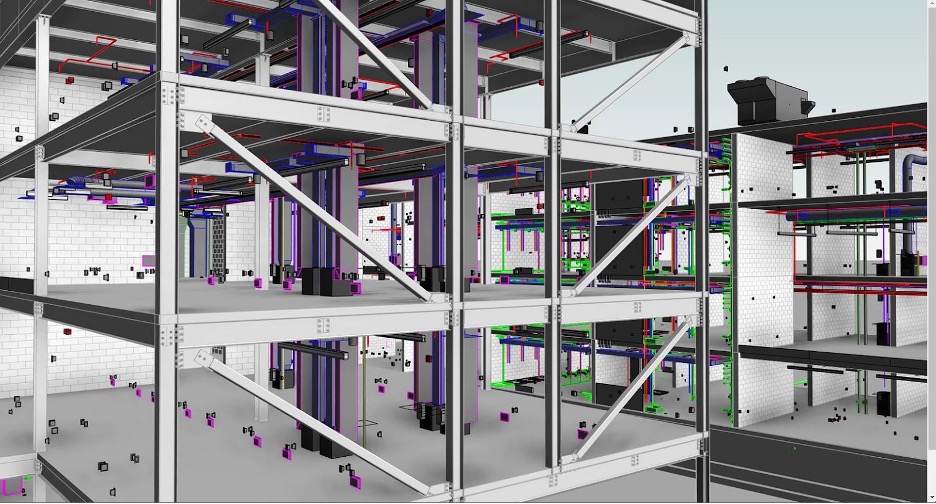
Coordinating functionality in Revit (Source)
This level of coordination allows teams to collaborate more closely and makes sure that no change goes uncommunicated.
Benefit 6: Overall better builds
In a construction project, every stage ensures the project’s overall success. A weak initial design will likely lead to a weak built design. If a construction project lacks proper leadership or cohesion among teams, it can lead to wasted time and materials, increased risks for injury, and overlooked tasks.
Conversely, a strong construction plan paves the way for a smooth implementation, and a smooth implementation paves the way to a successful finished product. BIM helps facilitate every stage of the building process, and as a result, 33% of its users say one of its benefits is overall better builds.
One reason for this may be BIM’s ability to help construction teams visualize projects, zooming in on the interior details and zooming out to the building’s exterior and surrounding area. In Giraffe, users can access 3D models of the building project and see it in context.

Site analysis in Giraffe (Source)
This can help teams anticipate challenges, take advantage of existing infrastructure, and better understand what the built project will look like in relation to its environment.
Being able to share, manage, and organize this data helps keep everyone involved in the project connected, which makes for smooth implementations and better overall builds.
Challenges of using BIM (with mitigation strategies)
Although BIM offers users many benefits, it is equally important to acknowledge the challenges it can present to first-time users.
Here are three potential BIM challenges Gartner outlined in “Innovation Insight for Building Information Modeling” [1].
Challenge 1: Gaining user acceptance
People can be resistant to change, and one challenge might be getting others on board. Construction workers and engineers might be reluctant to learn a new system, and business decision-makers, such as COOs, facility managers, and operations might be hesitant to embrace BIM without knowing what kind of impact it will have on operations.
Mitigation strategy
When buying any new software for your business, always include representatives from every department to weigh in on needs and concerns. Talk with people from different departments to see what challenges they face in different parts of processes and then collaborate with them to find potential BIM platforms that could address those challenges. Make notes of concerns people have and ask different BIM vendors how these concerns can be minimized.
Challenge 2: Prolonged implementation periods
There is a high risk that implementing new BIM software will take longer than you expect, which can also mean higher costs and a temporary lack of data governance. This can also result in a lower return on investment than anticipated.
Mitigation strategy
Software implementations do not happen overnight. They are often lengthy and require patience. Mitigate this challenge by planning for a long implementation period. Talk with your BIM vendor about realistic timelines so you can better manage your expectations and budget.
Challenge 3: Inflexible BIM models
Although BIM can be a valuable asset, if a BIM model is built inflexibly or incorrectly, it can negatively impact the built project.
Mitigation strategy
New BIM software will require a learning curve. Make sure you choose a BIM software vendor who is willing to work with you and offer ongoing support and training opportunities. Learn from the vendor how to build flexible models that will offer guidance throughout the project.
Tips for adopting BIM
If you want to invest in BIM software, it is important to understand the benefits, challenges, and how to overcome common challenges.
To ensure your adoption of BIM is successful, Gartner recommends gaining support from senior executives and business leaders, breaking the implementation process into phases and starting with smaller focused projects, assigning IT architects during the implementation phase to address data architecture challenges [1].
Check out user reviews of top-rated BIM software vendors and compare options to get started.
Survey methodology
* Software Advice's 2023 Construction Feedback Survey was conducted in January 2023 among 301 U.S. respondents to learn more about construction software and its benefits. Respondents were screened to be a construction professional that has some role in selection/purchase of construction software.
Sources
The applications mentioned in this article are examples to show a feature in context and are not intended as endorsements or recommendations.